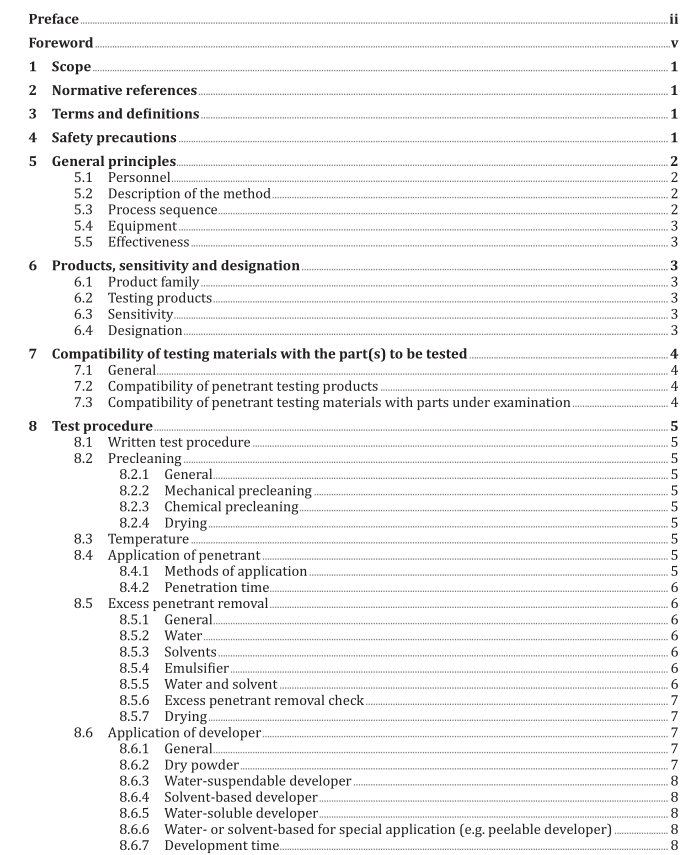AS ISO 3452.1 pdf download – Non-destructive testing – Penetrant testing Part 1: General principles

AS ISO 3452.1 pdf download – Non-destructive testing – Penetrant testing Part 1: General principles
The penetrant testing products and equipment shall be used with care and always in compliance with the instructions supplied by the manufacturer. When using filtered UV-A sources, care shall be taken to ensure that unfiltered radiation from the UV-A source does not directly reach the eyes of the operators. Whether it forms an integral part of the lamp or is a separate component, the UV-A filter shall always be maintained in good condition. In addition to the need to follow legislation (e.g. Directive 2006/25/EC), care shall be taken to ensure the safe implementation of the method.
5 General principles
5.1 Personnel Testing shall be carried out by proficient, suitably trained and qualified personnel and, where applicable, shall be supervised by competent personnel nominated by the employer or, by delegation of the employer, the inspection company in charge of testing. To demonstrate appropriate qualification it is recommended that personnel be certified according to ISO 9712 or an equivalent formalized system. Operating authorization for qualified persons shall be issued by the employer in accordance with a written procedure. Non-destructive testing (NDT) operations, unless otherwise agreed, shall be authorized by a competent and qualified NDT supervisory individual (Level 3 or equivalent) approved by the employer.
5.2 Description of the method Prior to penetrant testing the surface to be inspected shall be cleaned and dried. Suitable penetrants are then applied to the test area and enter into discontinuities open to the surface. After the appropriate penetration time has elapsed the excess penetrant is removed from the surface and the developer applied. The developer absorbs the penetrant that has entered and remains in the discontinuities and may give a clearly visible enhanced indication of the discontinuity. Should complementary NDT be required, the penetrant inspection shall be performed first, unless otherwise agreed upon between the contracting parties, so as not to introduce contaminants into open discontinuities. If penetrant inspection is used following another NDT technique, the surface shall be cleaned carefully to remove contaminants before application.
5.3 Process sequence
Testing generally proceeds through the following stages:
a) preparation and precleaning (see 8.2);
b) application of penetrant (see 8.4);
c) excess penetrant removal (see 8.5);
d) application of developer (see 8.6);
e) inspection (see 8.7);
f) recording (see 8.7.4);
g) postcleaning (see 8.8.1).
See Annex A.
5.4 Equipment
The equipment used for carrying out penetrant testing depends on the number, size and shape of the parts to be tested. The equipment shall be as specified in ISO 3452-4.
5.5 Effectiveness
The effectiveness of the penetrant testing depends upon many factors, including
a) types of penetrant materials and testing equipment,
b) surface preparation and condition;
c) material under examination and expected discontinuities,
d) temperature of the test surface,
e) penetration and development time, and
f) viewing conditions.
Control checks shall be carried out to demonstrate that the correct parameters are used. See Annex B.
6 Products, sensitivity and designation
6.1 Product family
Various test systems exist in penetrant testing.
A product family is understood as a combination of the following penetrant testing materials: penetrant, excess penetrant remover (except method A) and developer. When tested in accordance with ISO 3452-2 the penetrant and excess penetrant remover shall be from a single manufacturer. Only approved product families shall be used.
6.2 Testing products The products used for testing are given in Table 1.
6.3 Sensitivity The sensitivity level of a product family shall be determined using reference block 1 in accordance with ISO 3452-3. The assessed level always refers to the method used for type testing of the approved product family.
6.4 Designation The approved product family to be used for penetrant testing is given a designation comprising the type, the method and the form for the testing products, and a figure which indicates the sensitivity level achieved by testing with the reference block 1 according to ISO 3452-3. EXAMPLE An approved product family comprising fluorescent penetrant (I), water as the excess penetrant remover (A), a dry-powder developer (a), and a system sensitivity of level 2 gives the following penetrant testing system designation when using ISO 3452-1 and ISO 3452-2: product family ISO 3452-2, IAa Level 2.









